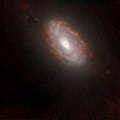NGC 23
| Galaxie NGC 23 | |
|---|---|
 | |
| SDSS-Aufnahme | |
| AladinLite | |
| Sternbild | Pegasus |
| Position Äquinoktium: J2000.0, Epoche: J2000.0 | |
| Rektaszension | 00h 09m 53,41s[1] |
| Deklination | +25° 55′ 25,6″[1] |
| Erscheinungsbild | |
| Morphologischer Typ | SB(s)ab / HII / LIRG / Sbrst[1] |
| Helligkeit (visuell) | 11,9 mag[2] |
| Helligkeit (B-Band) | 12,8 mag[2] |
| Winkelausdehnung | 2,1′ × 1,3′[2] |
| Positionswinkel | 174,2°[2] |
| Flächenhelligkeit | 12,8 mag/arcmin²[2] |
| Physikalische Daten | |
| Zugehörigkeit | NGC 23-Gruppe LGG 2[1][3] |
| Rotverschiebung | 0.015227 ± 0.000007[1] |
| Radialgeschwindigkeit | (4565 ± 2) km/s[1] |
| Hubbledistanz H0 = 73 km/(s • Mpc) | (211 ± 15) · 106 Lj (64,8 ± 4,5) Mpc [1] |
| Durchmesser | 130.000 Lj[4] |
| Geschichte | |
| Entdeckung | Wilhelm Herschel |
| Entdeckungsdatum | 10. September 1784 |
| Katalogbezeichnungen | |
| NGC 23 • UGC 89 • PGC 698 • CGCG 477-62 • CGCG 478-34 • MCG +04-01-033 • IRAS 00073+2538 • KUG 0007+256 • 2MASX J00095341+2555254 • Mrk 545 • GC 9 • H III 147 • GALEXASC J000953.40+255524.9 • NVSS J000953+255526 • WISEA J000953.41+255526.0 | |
NGC 23 ist eine aktive Balken-Spiralgalaxie mit hoher Sternentstehungsrate vom Hubble-Typ SBa im Sternbild Pegasus am Nordsternhimmel. Sie ist schätzungsweise 211 Millionen Lichtjahre von der Milchstraße entfernt und hat einen Durchmesser von etwa 130.000 Lichtjahren. Wahrscheinlich bildet sie gemeinsam mit NGC 26 ein gebundenes Galaxienpaar. Sie ist Mitglied der Galaxiengruppe LGG 2 oder NGC 23-Gruppe.
Aufnahmen
- Falschfarbendarstellung des Zentrums der Galaxie, aufgenommen mit der NICMOS-Kamera des HST bei 1,1 µm, 1,6 µm und 1,9 µm.
Die Supernova SN 1955C wurde hier entdeckt.[5]
Das Objekt wurde am 10. September 1784 vom deutsch-britischen Astronomen Wilhelm Herschel entdeckt.[6]
NGC 23-Gruppe
| Galaxie | Alternativname | Entfernung/Mio. Lj |
|---|---|---|
| NGC 1 | PGC 564 | 211 |
| NGC 23 | PGC 698 | 212 |
| NGC 26 | PGC 732 | 213 |
| PGC 912 | UGC 127 | 217 |
| PGC 619 | UGC 69 | 215 |
| PGC 654 | UGC 79 | 201 |
| PGC 830 | UGC 110 | 209 |
Weblinks
Einzelnachweise
Auf dieser Seite verwendete Medien
Autor/Urheber: Fabian RRRR, Lizenz: CC BY-SA 3.0
RGB composite of Hubble images made at wavelengths 1100nm, 1600nm and 1900nm. The composite is logarithmic scales and done by Aladin-software (2000A&AS..143...33B.)
The Observation is don for http://archive.stsci.edu/proposal_search.php?mission=hst&id=10169
Data Use Policy
Although there is no cost involved in retrieving data from MAST, researchers are requested to include an acknowledgement (as shown below) in any publications that make use of data obtained from MAST:
"Some/all of the data presented in this paper were obtained from the Multimission Archive at the Space Telescope Science Institute (MAST). STScI is operated by the Association of Universities for Research in Astronomy, Inc., under NASA contract NAS5-26555. Support for MAST for non-HST data is provided by the NASA Office of Space Science via grant NAG5-7584 and by other grants and contracts."
Users wishing to use documents obtained from the MAST web site for other than personal use, should first contact the MAST staff at archive@stsci.edu regarding neccessary permissions and acknowledgements.
All refereed publications based on data obtained from the Hubble Legacy Archive (HLA) are requested to carry the following footnote:
Based on observations made with the NASA/ESA Hubble Space Telescope, and obtained from the Hubble Legacy Archive, which is a collaboration between the Space Telescope Science Institute (STScI/NASA), the Space Telescope European Coordinating Facility (ST-ECF/ESA) and the Canadian Astronomy Data Centre (CADC/NRC/CSA).
In addition, publications of research supported by an ST ScI grant must carry the following acknowledgment:
Support for Program number ____________ was provided by NASA through a grant from the Space Telescope Science Institute, which is operated by the Association of Universities for Research in Astronomy, Incorporated, under NASAcontract NAS5-26555.Autor/Urheber: Sloan Digital Sky Survey, Lizenz: CC BY 4.0

Angle of view: 4' × 4' (0.3" per pixel), north is up.
Details on the image processing pipeline: https://www.sdss.org/dr14/imaging/jpg-images-on-skyserver/

